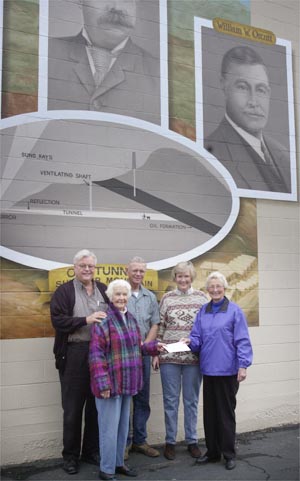In 1901 Orcutt was intrigued by the La Brea tar pits just west of Los Angeles. He found evidence of a scientific treasure house - “a mosaic of white bones, uniform in shape, lying in an exact pattern...a beautiful contrast with the black surface of the hard asphaltum.”Orcutt kept his discovery quiet to save the tar pits from “relic hunters,” eventually contacting the University of California in Berkeley who confirmed the find in 1906. Thereafter scientists from many universities and museums were digging through the “muck” to recover thousands of bones of prehistoric animals. These priceless remains have been on exhibit at the la Brea Tar Pits in Los Angeles for many years and have fascinated thousands of visitors.In 1908 Orcutt became Union Oil’s chief geologist, land department manager and a company director. In 1922 he was named vice president of Union Oil.

|
Joyce Carlson (right), chairperson of the Murals of Santa Paula, receives a check from Mrs. Alice Orcutt on behalf of the Orcutt Family. Additional descendants of William W. Orcutt (shown above in Mural) are: (back row left to right) Bill Orcutt, grandson; Marshall Orcutt grandson; and Mary Alice Orcutt Henderson, grandaughter. Photo by Don Johnson |
Orcutt family becomes a founder of Santa Paula murals
November 23, 2001
Santa Paula News
By Joyce Carlson
Murals of Santa PaulaSeveral members of the family of William W. Orcutt, pioneer in the oil industry in early Santa Paula, have become the latest founder of the Murals of Santa Paula. Joyce Carlson, in receiving their contribution, commented, “We are thrilled to have the Orcutt family’s generous support of the latest mural in Santa Paula. Major gifts such as theirs are a tremendous help to us as we move ahead to reach our goal of 10 historical murals in Santa Paula.”William W. Orcutt, one of the three men whose portraits appear on the newest of Santa Paula’s murals, the “Discovery of Black Gold,” played a major role in Union Oil’s geology and exploration operations for some 40 years.Orcutt grew up in Santa Paula where as a youth he sometimes worked at odd jobs at the Union Oil refinery before entering Stanford to study engineering and geology. One of Stanford’s first four-year graduates, he was a member of the pioneer class of 1895.Hired by Union Oil in 1899, Orcutt was soon running the geology program. He made the first geology maps of many of California’s most important oil fields. One of the industry’s most gifted explorers, he developed a staff of top-flight oil finders and built a reputation as the dean of West Coast petroleum geologists.


